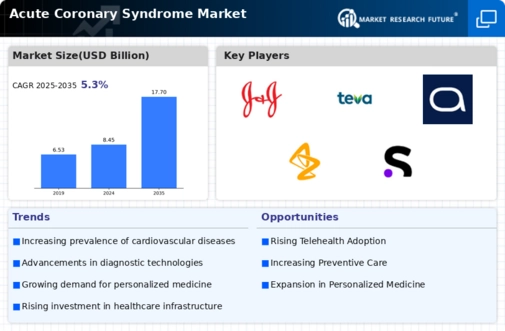Market Analysis
In-depth Analysis of Acute Coronary Syndrome Market Industry Landscape
Acute coronary syndrome (ACS) market dynamics mean that several factors interact as a result of advances in medicine, heightened awareness of the significance of cardiovascular diseases and the world’s response to cardiac emergencies. ACS, which include unstable angina and myocardial infarction, is an essential part of cardiovascular health that influences both diagnosis and treatment options. The incidence of cardiovascular disease has been observed to be increasing globally with particular attention on the aged patients necessitating accurate diagnosis tools and ACS’ effective treatment options.
Increased understanding about the importance of early intervention through awareness campaigns about risk factors for heart diseases has greatly influenced ACS’s market. With cases related to lifestyles contributing towards the increased prevalence of ACS, there is now more focus on prevention rather than cure. This has led to the development as well as adoption of novel diagnostic methods such as electrocardiography (ECG), determination biomarkers assay for heart muscle damage and imaging studies like coronary angiography. Early and accurate diagnosis are critical for initiating timely interventions like revascularization or pharmacological treatments aimed at improving outcomes among individuals suffering from ACS.
Technological advancements have played a key role in enhancing market dynamics of ACS diagnosis and treatments. Advanced imaging techniques such as CT angiography, MRI contribute to better understanding coronary artery anatomy along with cardiac function. Furthermore, interventional cardiology advances involving drug eluting stents along with percutaneous coronary intervention (PCI) procedures have completely changed how acute coronary syndrome is treated. These technological steps not only assist in swift plus correct diagnoses but also offer healthcare providers numerous ways to effectively manage this condition.
The global healthcare landscape’s increasing focus on cardiovascular health together with pervasiveness morbidity/mortality related to ACS has driven research and development efforts. Pharmaceutical companies collaborate with research institutions and healthcare professionals to develop new therapies for those affected by acute coronary syndrome. Antiplatelet agents, beta-blockers, statins alongside new anticoagulants are now emerging as central components of pharmacological management of ACS, aiming to prevent further cardiovascular events and improve overall prognosis. This increase in therapeutic choices is one of the positive factors influencing market dynamics for ACS.
The competitive landscape of ACS market comprises cardiology specialized pharmaceutical companies, medical devices manufacturers among others who collaborates in developing new treatments. Market dynamics can be deduced from clinical trials/research initiatives aimed at exploring new treatment approaches. For example, collaboration between stakeholders is important in advancing research on ACS as well as fostering innovation that will ensure effective treatment options are available.
On the other hand, obstacles to the dynamic nature of the market include multiple types of presentations seen in ACS, various levels of severity and need for personalized treatment plans. The spectrum for this disease includes unstable angina up to ST-segment elevation myocardial infarction (STEMI) with every case requiring specific strategies for managing them. Moreover, overcoming disparities in healthcare access and ensuring timely intervention across different healthcare settings are critical issues that must be considered when managing ACS globally.








Leave a Comment